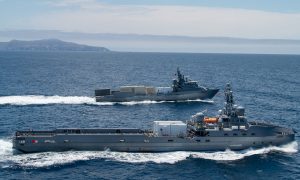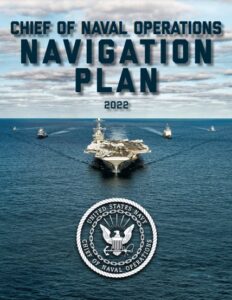The latest Navigation Plan (NAVPLAN) released on Tuesday by Chief of Naval Operations Adm. Mike Gilday includes recommendations from the Navy requiring over 350 manned vessels.
This latest NAVPLAN is a follow-up to a previous document published in January 2021 that aims to further outline the Navy will build, maintain, train and equip a “dominant naval force to strengthen strategic partnerships, deter conflict, and if called upon, help win the Nation’s wars.”
The plan seeks to align the Navy’s vision with the most up-to-date strategic guidance, including the 2022 National Defense Strategy and Secretary of the Navy’s vision.
This “outlines how the Navy is uniquely positioned to strengthen integrated deterrence, campaign forward, and build enduring warfighting advantages. This update also supports these lines of effort by driving a Fleet-wide movement to strengthen Navy’s learning culture and advancing a framework to accelerate its warfighting advantage,” the service said.
NAVPLAN 2022 particularly includes the outlines of Force Design 2045, which covers the surface, subsurface and aviation platform types needed to meet the Navy’s defense commitments when combined with the right concepts, capabilities, information systems and networks.
In the plan, Gilday argued “this complements the Navy’s 30-year shipbuilding plan and Force Structure Assessments with a long-term strategic vision that leverages organizational learning across the Navy, including war-gaming, analysis, and research and development into emerging technologies. Strategic competition with China is both a current and long-term challenge. Focusing our force design on 2045 will inform the most consequential decisions and investments the Navy needs to make in the critical decade ahead.”
The NAVPLAN said this fore design reinforces the need to shift the fleet to a larger, more capable and more distributed force to support missions of homeland defense, deterrence, and defeating adversaries in conflict.
To meet these goals, Gilday said by about 2045 the Navy should include “more than” 350 manned ships, 150 large unmanned surface and subsurface platforms and about 3,000 aircraft.
The Navy specifically forecasts the fleet to include a capacity goal of 12 Columbia-class nuclear ballistic missile submarines; 12 aircraft carriers; 66 nuclear-powered fast-attack and large payload submarines like the Virginia-class submarine and future SSN(X); 96 large surface combatants like the Arleigh Burke-class destroyer and future DDG(X) successor; 56 small surface combatants like Littoral Combat Ships and the upcoming Constellation-class frigates; 31 amphibious assault ships and 18 Light Amphibious Warships; 150 unmanned vessels; and 82 combat logistics ships and auxiliary vessels.
These numbers are broadly similar to former Secretary of Defense Mark Esper’s Battle Force 2045 plans, which called for over 500 naval vessels, including unmanned ships (Defense Daily, Oct. 6, 2020).
The NAVPLAN said the unmanned platforms will “increase the fleet’s capacity for distribution; expand our intelligence, surveillance, and reconnaissance advantage; add depth to our missile magazines; supplement logistics; and enhance fleet survivability.”
The CNO argued the transition to adding unplanned vessels will help rebalance the fleet away from relying on “exquisite, manpower intensive platforms toward smaller, less-expensive, yet lethal ones.”
Force Design 2045 also recommends 1,300 long-range carrier-based aircraft to include a mix of F-35 5th Generation manned aircraft and the next Generation Air Dominance (NGEN) family of systems; 900 aircraft for anti-submarine and anti-surface warfare like helicopters, maritime patrol and reconnaissance aircraft, and unmanned aircraft; and 750 support aircraft including intra-theater lift and training aircraft.

NAVPLAN said the Navy will augment its overall force with “an evolving complement of thousands of small, rapidly adaptable, and attritable unmanned platforms.”
The small unmanned platforms aim to increase the Navy’s sensing resilience, persistence, coverage, survivability and sustainability of the future fleet.
However, Gilday argued these plans required sustained budget increases for the Navy, or it risks prioritizing modernization over maintaining a certain fleet size.
“To simultaneously modernize and grow the capacity of our fleet, the Navy will require 3-5% sustained budget growth above actual inflation. Short of that, we will prioritize modernization over preserving force structure. This will decrease the size of the fleet until we can deploy smaller, more cost-effective, and more autonomous force packages at scale.”
This comes after the Navy’s sent its 30-year shipbuilding plan to Congress in April for the first time outlining three options, with two assuming a flat top line budgets to reach 318 or 322 ships by 2045 and a third reaching 363 ships assuming $75 billion in real growth starting in five years (Defense Daily, April 20).
